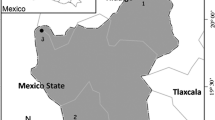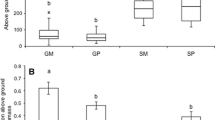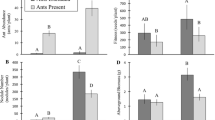Abstract
Studies on the effect of plant-species diversity on various ecological processes has led to the study of the effects of plant-genetic diversity in the context of community genetics. Arthropod diversity can increase with plant-species or plant-genetic diversity (Wimp et al. in Ecol Lett 7:776–780, 2004). Plant diversity effects can be difficult to separate from other ecological processes, for example, complementarity. We asked three basic questions: (1) Are arthropod communities unique on different host-plant genotypes? (2) Is arthropod diversity greater when associated with greater plant-genetic diversity? (3) Are arthropod communities more closely associated with host-plant genetics than the plant neighborhood? We studied canopy arthropods on Populus fremontii trees randomly planted in a common garden. All trees were planted in a homogeneous matrix, which helped to reduce P. fremontii neighborhood effects. One sample was comprised of few P. fremontii genotypes with many clones. A second sample was comprised of many P. fremontii genotypes with few clones. A second data set was used to examine the relationships between the arthropod community with P. fremontii genetic composition and the neighborhood composition of the focal host plant. Unique arthropod communities were associated with different P. fremontii genotypes, and arthropod community diversity was greater in the sample with greater P. fremontii genotypic diversity. Arthropod community similarity was negatively correlated with P. fremontii genetic distance, but arthropod community similarity was not related to the neighborhood of the P. fremontii host plant.





Similar content being viewed by others

References
Addicott JF, Aho JM, Antolin MF, Padilla DK, Richardson JS, Soluk DA (1987) Ecological neighborhoods: scaling environmental patterns. Oikos 49:340–346
Anderson MJ (2001) A new method for non-parametric multivariate analysis of variance. Aust Ecol 26:32–46
Anderson MJ (2004) PERMDISP: permutational analysis of multivariate dispersions. http://www.stat.auckland.ac.nz/~mja/Programs.htm. Accessed 1 Feb 2010
Anderson MJ, Willis TJ (2003) Canonical analysis of principal coordinates: a useful method of constrained ordination for ecology. Ecology 84:511–525
Antonovics J (1992) Toward community genetics. In: Fritz RS, Simms EL (eds) Plant resistance to herbivores and pathogens. University of Chicago Press, Chicago, pp 426–449
Antonovics J (2003) Toward community genomics? Ecology 84:598–601
Atsatt PR, O’Dowd DJ (1976) Plant defense guilds. Science 193:24–29
Bailey JK, Wooley SC, Lindroth RL, Whitham TG (2006) Importance of species interactions to community heritability: a genetic basis to trophic-level interactions. Ecol Lett 9:78–85
Bailey JK, Schweitzer JA, Úbeda F, Koricheva J, Madritch MD, LeRoy CJ, Rehill BJ, Bangert RK, Fisher DG, Allan GJ, Whitham TG (2009) From genes to ecosystems: a synthesis of the effects of plant genetic factors across levels of organization. Philos Trans R Soc Lond B Biol Sci 364:1607–1616
Bangert RK, Whitham TG (2007) Genetic assembly rules and community phenotypes. Evol Ecol 21:549–560
Bangert RK, Turek RJ, Martinsen GD, Wimp GM, Bailey JK, Whitham TG (2005) Benefits of conservation of plant genetic diversity on arthropod diversity. Cons Biol 19:379–390
Bangert RK, Turek RJ, Rehill B, Wimp GM, Schweitzer JA, Allan GJ, Bailey JK, Martinsen GD, Keim P, Lindroth RL, Whitham TG (2006) A genetic similarity rule determines arthropod community structure. Mol Ecol 15:1379–1392
Barbour RC, O’Reilly-Wapstra JM, DeLittle DW, Jordan GJ, Steane DA, Humphreys JR, Bailey JK, Whitham TG, Potts BM (2009) A geographic mosaic of genetic variation within a foundation tree species and its community-level consequences. Ecology 90:1762–1772
Booth RE, Grime JP (2003) Effects of genetic impoverishment on plant community diversity. J Ecol 91:721–730
Bray JR, Curtis JT (1957) An ordination of the upland forest communities of southern Wisconsin. Ecol Monogr 27:325–349
Casgrain P, Legendre P (2001) The R Package for multivariate and spatial analysis. V.4.06d. http://www.bio.umontreal.ca/Casgrain/en/labo/R/v4/index.html. Accessed 1 Feb 2010
Colwell RK (2006) EstimateS: statistical estimation of species richness and shared species from samples. Version 8.0. http://purl.oclc.org/estimates. Accessed 1 Feb 2010
Crutsinger GM, Collins MD, Fordyce JA, Gompert Z, Nice CC, Sanders NJ (2006) Plant genotypic diversity predicts community structure and governs an ecosystem process. Science 313:966–968
Dungey HS, Potts BM, Whitham TG, Li H-F (2000) Plant genetics affects arthropod community richness and composition: evidence from a synthetic eucalypt hybrid population. Evolution 54:1938–1946
Ellison AM, Bank MS, Clinton BD, Colburn EA, Elliott K, Ford CR, Foster DR, Kloeppel BD, Knoepp JD, Lovett GM, Mohan J, Orwig DA, Rodenhouse NL, Sobczak WV, Stinson KA, Stone JK, Swan CM, Thompson J, Von Holle B, Webster JR (2005) Loss of foundation species: consequences for the structure and dynamics of forested ecosystems. Front Ecol Environ 3:479–486
Excoffier L, Smouse PE, Quattro JM (1992) Analysis of molecular variance inferred from metric distances amoung DNA haplotypes: application to human mitochondrial DNA restriction data. Genetics 131:479–491
Feeny P (1976) Plant apparency and chemical defense. In: Wallace JW, Mansell RL (eds) Biochemical interactions between plants and insects. Recent advances in phytochemistry, vol 10. Plenum, New York, pp 1–40
Fritz RS, Price PW (1988) Genetic variation among plants and insect community structure: willows and sawflies. Ecology 69:845–856
Hughes AR, Stachowicz JJ (2004) Genetic diversity enhances the resistance of a seagrass ecosystem to disturbance. Proc Natl Acad Sci USA 101:8998–9002
Hughes AR, Inouye BD, Johnson MTJ, Underwood N, Vellend M (2008) Ecological consequences of genetic diversity. Ecol Lett 11:609–623
Hunter MD, Price PW (1992) Playing chutes and ladders: heterogeneity and the relative roles of bottom-up and top-down forces in natural communities. Ecology 73:724–732
Hurlbert SH (1984) Pseudoreplication and the design of ecological field experiments. Ecol Monogr 54:187–211
Huston MA (1997) Hidden treatments in ecological experiments: re-evaluating the ecosystem function of biodiversity. Oecologia 110:449–460
Johnson MTJ, Agrawal AA (2005) Plant genotype and the environment interact to shape a diverse arthropod community on evening primrose (Oenothera biennis). Ecology 84:874–885
Johnson MTJ, Lajeunesse MJ, Agrawal AA (2006) Additive and interactive effects of plant genotypic diversity on arthropod communities and plant fitness. Ecol Lett 9:24–34
Keith AR, Bailey JK, Whitham TG (2010) A genetic basis to community repeatability and stability. Ecology 91:3398–3406
Knops JMH, Tilman D, Haddad NM, Naeem S, Mitchell CE, Haarstad J, Ritchie ME, Howe KM, Reich PB, Siemann E, Groth J (1999) Effects of plant species richness on invasion dynamics, disease outbreaks, insect abundances and diversity. Ecol Lett 2:286–293
Legendre P, Legendre L (1998) Numerical ecology, 2nd edn. Elsevier, Amsterdam
Manly BFJ (1997) Randomization and Monte Carlo methods in biology, 2nd edn. Chapman and Hall, New York
Mantel N (1967) The detection of disease clustering and a generalized regression approach. Cancer Res 27:209–220
McLeod MA, Koronkiewicz TJ, Brown BT, Carothers SW (2005) Southwestern willow flycatcher surveys, demography, and ecology along the Lower Colorado River and tributaries, 2004. U.S Bureau of Reclamation, Boulder City
Morin PJ (2003) Community ecology and the genetics of interacting species. Ecology 84:577–580
Murdoch WW, Evans FC, Peterson CH (1972) Diversity and pattern in plants and insects. Ecology 53:819–829
Naeem S (2002) Ecosystem consequences of biodiversity loss: the evolution of a paradigm. Ecology 83:1537–1552
Naeem S, Thompson LJ, Lawler SP, Lawton JH, Woodfin RM (1994) Declining biodiversity can alter the performance of ecosystems. Nature 368:734–737
Neuhauser C, Andow DA, Heimpel GE, May G, Shaw RG, Wagenius S (2003) Community genetics: expanding the synthesis of ecology and genetics. Ecology 84:545–558
O’Reilly-Wapstra JM, Bailey JK, McArthur C, Potts BM (2010) Genetic and chemical based resistance to two mammalian herbivores varies across the geographic range of Eucalyptus globulus. Evol Ecol Res 12:491–505
Peakall R, Smouse PE (2006) GENALEX 6: genetic analysis in Excel. Population genetic software for teaching and research. Mol Ecol Notes 6:288–295
Petit RJ, El Mousadik A, Pons O (1998) Identifying populations for conservation on the basis of genetic markers. Conserv Biol 12:844–855
Reusch TBH, Ehlers A, Hämmerli A, Worm B (2005) Ecosystem recovery after climatic extremes enhanced by genotypic diversity. Proc Natl Acad Sci 102:2826–2831
Schulze ED, Mooney HA (eds) (1993) Biodiversity and ecosystem function. Springer, New York
Schweitzer JA, Martinsen GD, Whitham TG (2002) Cottonwood hybrids gain fitness traits of both parents: a mechanism for their long-term persistence? Am J Bot 89:981–990
Schweitzer JA, Bailey JK, Rehill BJ, Martinsen GD, Hart SC, Lindroth RL, Keim P, Whitham TG (2004) Genetically based trait in a dominant tree affects ecosystem processes. Ecol Lett 7:127–134
Schweitzer JA, Bailey JK, Hart SC, Whitham TG (2005) Nonadditive effects of mixing cottonwood genotypes on litter decomposition and nutrient dynamics. Ecology 86:2834–2840
Schweitzer JA, Bailey JK, Bangert RK, Hart SC, Whitham TG (2007) The role of plant genetic variation in determining above- and belowground microbial communities. In: Bailey MJ, Lilley AK, Timms-Wilson TM, Spencer-Phillips PTN (eds) Microbial Ecology of Arial Plant Surfaces. CABI, Oxfordshire, pp 109–119
Schweitzer JA, Bailey JK, Fischer DG, LeRoy CJ, Lonsdorf EV, Whitham TG, Hart SC (2008) Plant-soil-microorganism interactions: heritable relationship between plant genotype and associated soil microorganisms. Ecology 89:773–781
Shuster SM, Lonsdorf EV, Wimp GM, Bailey JK, Whitham TG (2006) Community heritability measures the evolutionary consequences of indirect genetic effects on community structure. Evolution 60:991–1003
Siegal S, Castellan NJ Jr (1988) Nonparametric statistics for the behavioral sciences, 2nd edn. McGraw-Hill, New York
Siemann E (1998) Experimental tests of effects of plant productivity and diversity on grassland arthropod diversity. Ecology 79:2057–2070
Siemann E, Tilman D, Haarstad J, Ritchie M (1998) Experimental tests of the dependence of arthropod diversity on plant diversity. Am Nat 152:738–750
Sokal RR, Rohlf FJ (1995) Biometry: the principles and practice of statistics in biological research, 3rd edn. WH Freeman, New York
Tahvanainen JO, Root RB (1972) Influence of vegetational diversity on the population ecology of a specialized herbivore, Phyllotreta cruciferae (Coleoptera: Chrysomelidae). Oecologia 10:321–346
Tilman D, Knops J, Wedin D, Reich P, Ritchie M, Siemann E (1997) The influence of functional diversity and composition on ecosystem processes. Science 277:1300–1302
Tuscan GA et al (2006) The genome of Black Cottonwood Populus trichocarpa (Torr. & Gray). Science 313:1596–1604
Wade MJ (2003) Community genetics and species interactions. Ecology 84:583–585
White JA, Whitham TG (2000) Associational susceptibility of cottonwood to a box elder herbivore. Ecology 81:1795–1803
Whitham TG, Martinsen GD, Floate KD, Dungey HS, Potts BM, Keim P (1999) Plant hybrid zones affect biodiversity: tools for a genetic based understanding of community structure. Ecology 80:416–428
Whitham TG, Young WP, Martinsen GD, Gehring CA, Schweitzer JA, Shuster SM, Wimp GM, Fischer DG, Bailey JK, Lindroth RL, Woolbright S, Kuske CR (2003) Community and ecosystem genetics: a consequence of the extended phenotype. Ecology 84:559–573
Whitham TG, Bailey JK, Schweitzer JA, Shuster SM, Bangert RK, LeRoy CJ, Lonsdorf E, Allan GJ, DiFazio SP, Potts BM, Fischer DG, Gehring CA, Lindroth RL, Marks J, Hart SC, Wimp GM, Wooley SC (2006) Community and ecosystem genetics: a framework for integrating from genes to ecosystems. Nat Rev Gen 7:510–523
Whitham TG, DiFazio SP, Schweitzer JA, Shuster SM, Allan GJ, Bailey JK, Woolbright SA (2008) Extending genomics to natural communities and ecosystems. Science 320:492–495
Whitham TG, Gehring CA, Evans LM, LeRoy CJ, Bangert RK, Schweitzer JA, Allan GJ, Barbour RC, Fischer DG, Potts BM, Bailey JK (2010) A community and ecosystem genetics approach for conservation biology and management. In: DeWoody JA, Bickham JW, Michler C, Nichols K, Rhodes G, Woeste K (eds) Molecular approaches in natural resource conservation and management. Cambridge University Press, Cambridge, pp 50–70
Wimp GM, Young WP, Woolbright SA, Martinsen GD, Keim P, Whitham TG (2004) Conserving plant genetic diversity for dependent animal communities. Ecol Lett 7:776–780
Acknowledgments
We thank Reclamation for grant number CESU-06FC300025 and California Game and Fish for the land to plant the garden. We also thank the Cottonwood Ecology Group and anonymous reviewers for constructive comments.
Author information
Authors and Affiliations
Corresponding authors
Additional information
First authorship shared by Sharon M. Ferrier and Randy K. Bangert.
Handling Editor: Gary Felton.
Rights and permissions
About this article
Cite this article
Ferrier, S.M., Bangert, R.K., Hersch-Green, E.I. et al. Unique arthropod communities on different host-plant genotypes results in greater arthropod diversity. Arthropod-Plant Interactions 6, 187–195 (2012). https://doi.org/10.1007/s11829-011-9177-9
Received:
Accepted:
Published:
Issue Date:
DOI: https://doi.org/10.1007/s11829-011-9177-9



